Why pumpkin is useful for type 1 and type 2 diabetes and how to cook it in the most delicious ways
Diabetes mellitus ranks third among the most common diseases, after pathologies of the cardiovascular system and oncology. The key to a fulfilling life is a healthy diet, control of sugar levels and avoiding prohibited foods. Fortunately, pumpkin is not on this list.
In this article, we'll talk about the benefits and dangers of pumpkin for type 1 and type 2 diabetes. You will learn how to properly prepare a vegetable and in what form to use it.
The content of the article
Composition and useful properties
Nutritional value of pumpkin per 100 g:
- calorie content - 22 kcal;
- proteins - 1 g;
- fats - 0.1 g;
- carbohydrates - 4.4 g;
- water - 91.8 g;
- ash - 0.6 g;
- starch - 0.2 g;
- sugar - 4.2 g;
- glucose - 2.6 g;
- sucrose - 0.5 g;
- fructose - 0.9 g;
- fiber - 2 g.
Reference. The calorie content of cooked pumpkin is 28 kcal.
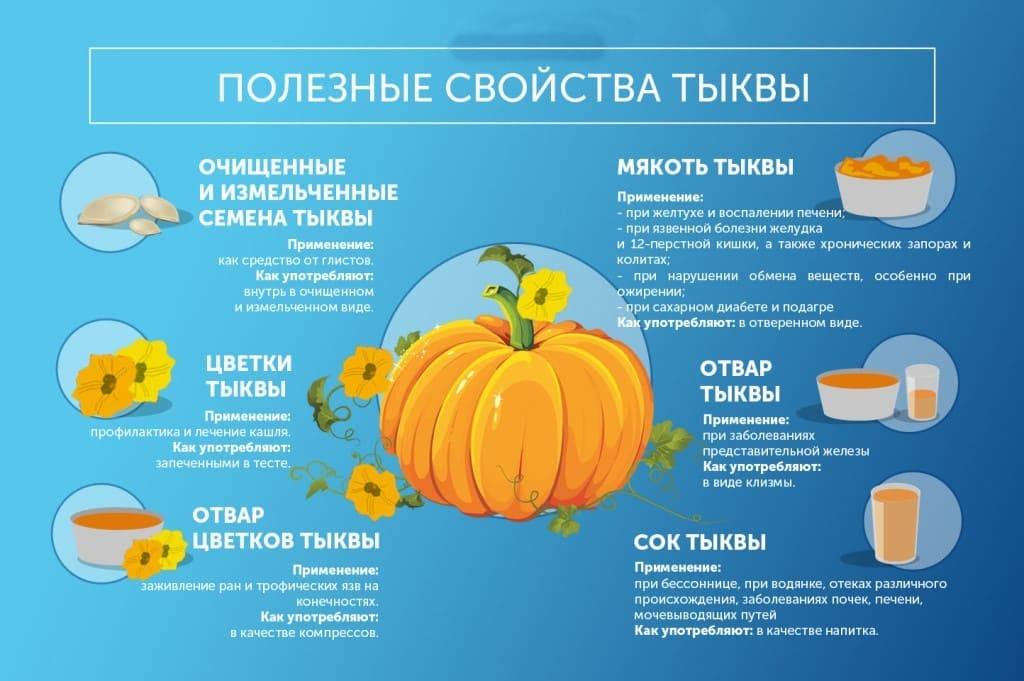
Vitamin and Mineral Content Table:
| Name | Content | Daily rate |
| Vitamin A | 250 mcg | 900 mcg |
| Beta carotene | 1.5 mg | 5 mg |
| Vitamin B1 (thiamin) | 0.05 mg | 1.5 mg |
| Vitamin B2 (riboflavin) | 0.06 mg | 1.8 mg |
| Vitamin B4 (choline) | 8.2 mg | 500 mg |
| Vitamin B5 (pantothenic acid) | 0.4 mg | 5 mg |
| Vitamin B6 (pyridoxine) | 0.13 mg | 2 mg |
| Vitamin B9 | 14 μg | 400 mcg |
| Vitamin C (ascorbic acid) | 8 mg | 90 mg |
| Vitamin E | 0.4 mg | 15 mg |
| Vitamin H (biotin) | 0.4 μg | 50 mcg |
| Vitamin K | 1.1 μg | 120 mcg |
| Vitamin PP | 0.7 mg | 20 mg |
| Potassium | 204 mg | 2500 mg |
| Calcium | 25 mg | 1000 mg |
| Silicon | 30 mg | 30 mg |
| Magnesium | 14 mg | 400 mg |
| Sodium | 4 mg | 1300 mg |
| Sulfur | 18 mg | 1000 mg |
| Phosphorus | 25 mg | 800 mg |
| Chlorine | 19 mg | 2300 mg |
| Iron | 0.4 mg | 18 mg |
| Iodine | 1 μg | 150 mcg |
| Cobalt | 1 μg | 10 mcg |
| Manganese | 0.04 mg | 2 mg |
| Copper | 180 mcg | 1000 mcg |
| Molybdenum | 4.6 μg | 70 mcg |
| Selenium | 0.3 μg | 55 mcg |
| Fluorine | 86 μg | 4000 mcg |
| Chromium | 2 μg | 50 mcg |
| Zinc | 0.24 mg | 12 mg |
The benefits of pumpkin:
- prevents the development of cancer cells;
- improves vision;
- strengthens the central nervous system;
- rejuvenates;
- regulates the processes of hematopoiesis;
- speeds up metabolism;
- cleans the digestive tract;
- restores the pancreas at the cellular level;
- normalizes sugar levels;
- improves the outflow of urine;
- helps to reduce weight.
Glycemic index and glycemic load
The glycemic index (GI) of pumpkin depends on how it is processed:
- raw pulp - 25 units;
- boiled - 75 units;
- baked - 75-85 units
Reference. GI is an indicator of an increase in blood sugar after eating certain foods.
The glycemic index does not show a complete picture of the effect of a particular product on the body. With a high carbohydrate content, glucose levels will rise, even with a low GI. This is the glycemic load, which should be guided by when drawing up a diabetic menu.
The glycemic load of boiled pumpkin, with a carbohydrate content of 4.4 g, is 3.15. This is a low indicator that allows you to include a vegetable in the diet for diabetes.
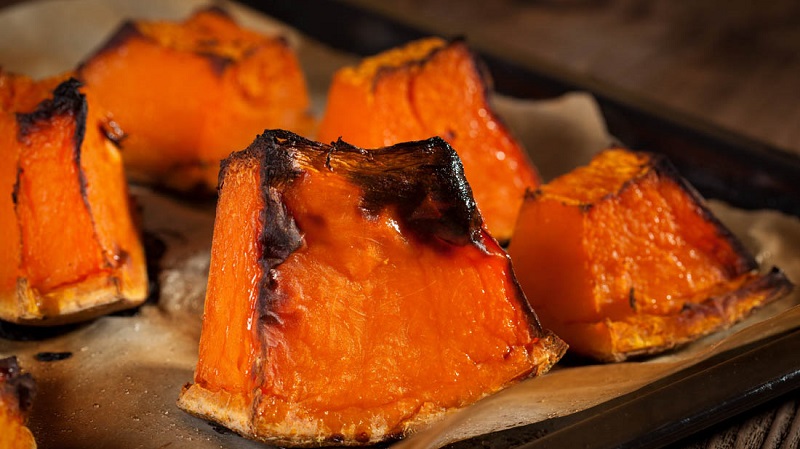
Natural insulin substitute: pumpkin for type 2 diabetes
Diabetes mellitus is a group of diseases that are united by an increase in blood glucose levels. This is an autoimmune pathology characterized by a malfunction of the pancreas, insufficient production of insulin, and impaired carbohydrate metabolism. The disease is divided into two groups: type 1 and type 2 diabetes mellitus.
Type 2 diabetes - non-insulin dependent, develops against the background of insufficient synthesis of pancreatic hormone. At the initial stage, the introduction of insulin is not necessary.
What is the use of pumpkin for diabetes? The fact is that with a relatively high carbohydrate content, but a low GI, the product promotes the formation of beta cells, which are responsible for the production of insulin. The cells are filled with glucose and the need for additional injections is reduced. It is thanks to these processes that the culture is called a natural substitute for the synthesized hormone.
Pumpkin for type 1 diabetes
Type 1 diabetes mellitus is insulin dependent. And this means that the patient needs a systematic introduction of the pancreatic hormone. No matter how much pumpkin pulp a person consumes in a day, this cannot force the body to synthesize insulin.
It is not forbidden to eat melons in type 1 diabetes. However, doctors recommend adjusting the amount consumed per day. The pulp contains a lot of starch, therefore, during heat treatment, the GI increases, which leads to surges in blood glucose. Diabetics are forced to constantly use the formula for calculating bread units (XE) in order to understand how much a product will not harm.
The norms are calculated depending on the lifestyle and weight. For example, with low physical activity and normal weight, the daily rate is 15 XE. 100 g of raw pumpkin - 0.5 XE.
Reference. XE is a measure that determines the amount of carbohydrates in foods. This is a constant 12 grams of carbohydrates. For convenience, tables have been created for determining XE and calculating daily norms.
Cooking rules
We have already found out that pumpkin can be eaten with diabetes. Nevertheless, the use of a vegetable should be approached from a rational point of view, after consulting a specialist.
A lot of tasty and healthy dishes can be prepared from melons and gourds. Vegetables can be eaten raw, boiled, baked. Seeds and pumpkin oil are added to the dishes. Remember that refined sugar is strictly prohibited. It is replaced with sweeteners or honey in small amounts.
Diabetic pumpkin porridge
To prepare a delicious meal, take the following foods:
- pumpkin pulp - 800 g;
- low-fat milk - 160 ml;
- sweetener - 1 tbsp. l .;
- couscous - 1 glass;
- dried fruits and nuts - 10 g;
- cinnamon.
Cut the peeled fruit into pieces and boil. Drain, add milk and sweetener to the pot. Add cereal and cook until cooked. When serving, add cinnamon, dried fruit and nuts.
Reference. Cinnamon lowers blood sugar.
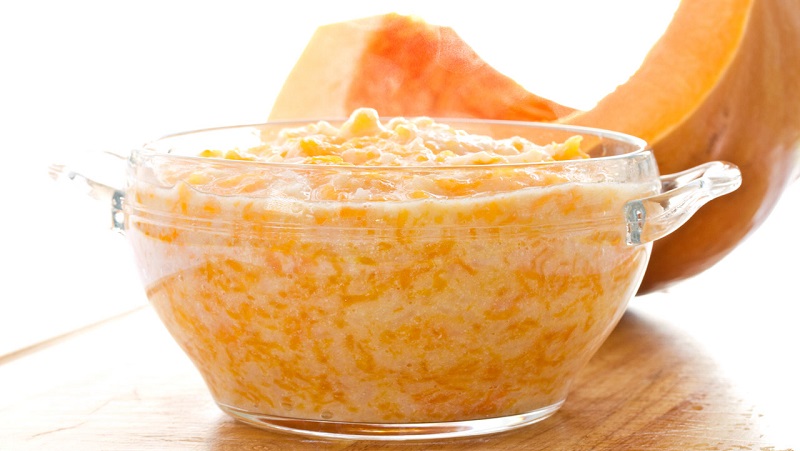
Pumpkin juice for diabetes
For type 2 diabetes, pumpkin juice can be consumed. The pulp contains 91.8% water, thereby eliminating toxins, normalizing blood circulation and replenishing fluid reserves.
Doctors recommend getting tested before adding juice to the diet. With a complicated course of the disease, it is better to refuse the product.
Natural vegetable juice
To prepare fresh pumpkin, the pulp is cut into pieces and passed through a meat grinder or juicer, rubbed on a grater. The mass is filtered through cheesecloth, the cake is thrown away. To adjust the taste of the drink, add lemon, orange or apple juice.
Cream Soup
Ingredients:
- pumpkin pulp - 600 g;
- cream 15% - 180 ml;
- broth - 500 ml;
- tomato - 2 pcs.;
- onion - 1 pc.;
- garlic - 1 slice.
Cut the peeled pumpkin into slices. Remove the skin from the tomatoes and chop randomly. Finely chop the onion and garlic and sauté in a soup container without vegetable oil. Use non-stick cookware. Add pumpkin, cream and broth. Simmer for half an hour. Then turn the food into a homogeneous mass with the hand blender. Season to taste and garnish with herbs when serving.
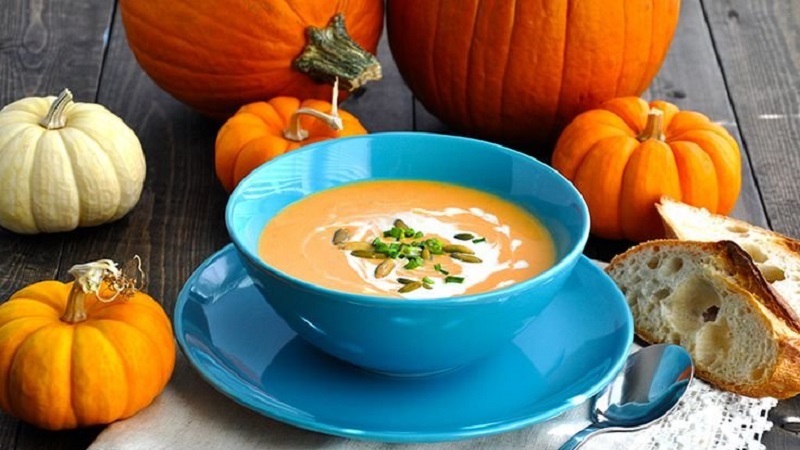
Mousse with nutmeg
Ingredients:
- pumpkin - 400 g;
- natural honey - 2.5 tbsp. l .;
- instant gelatin - 15 g;
- boiled water - 40 ml;
- cream 15% - 200 ml;
- lemon peel;
- nutmeg on the tip of a knife;
- ground cinnamon - 1 tsp.
Pour gelatin with water, stir and leave to swell.
Cut the pumpkin into slices and bake in the oven. Then, mash the pulp. Remove the zest from the lemon, add to the mass along with cinnamon and nutmeg. Stir in honey and pour in warmed cream (do not boil).
Put the gelatin in a water bath, bring to a liquid state and add to the pumpkin puree. Pour into molds and refrigerate.

Baked pumpkin with honey
This is the easiest pumpkin recipe, but the result will please you. Cut the peeled pulp into slices, pour over with liquid honey and send to the oven. Bake until soft, then sprinkle with nuts and serve.
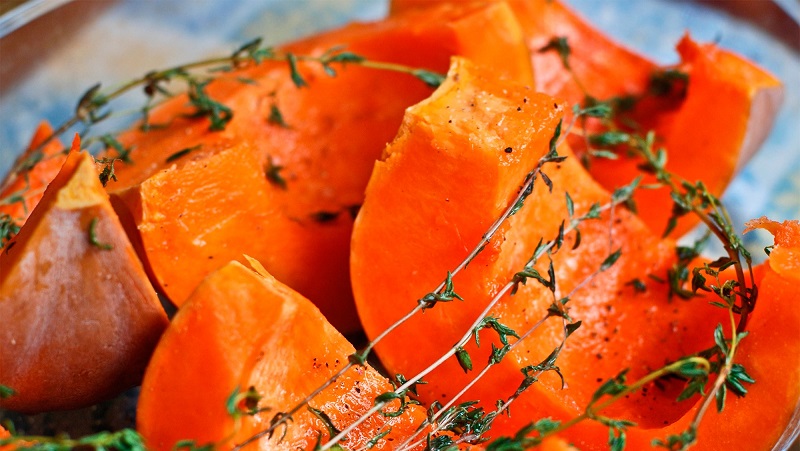
Diet salad
Ingredients:
- pumpkin - 200 g;
- carrots - 100 g;
- honey - 1 tbsp. l .;
- juice of one lemon;
- vegetable oil to taste.
This dish uses raw vegetables that need to be grated and squeezed out a little excess liquid. For dressing, mix honey, lemon juice and oil. Let the salad sit for 20-30 minutes.
Stuffed pumpkin
Ingredients:
- one small pumpkin;
- 200 g chicken fillet;
- 100 g sour cream 20%;
- spices and salt to taste.
Wash the vegetable, cut off the ponytail and remove the pulp. You should get a kind of pot. Set the fibrous part with the seeds aside, finely chop the rest of the pulp.
Finely chop the chicken fillet, mix with pumpkin, add sour cream, salt and pepper. Fill the "pot" with the resulting mass and bake at 180 ° C for 1 hour. Add water to the baking sheet periodically.
The benefits of pumpkin seeds
Sunflower seeds belong to dietary products and are included in the main menu of diabetics. Scientists have proven that when consumed regularly, seeds can lower blood glucose levels. This is due to its high fiber content. In addition, the product helps to cleanse the body of toxins and toxins, normalizes metabolism, prevents the formation of kidney stones, and lowers the level of "bad" cholesterol.
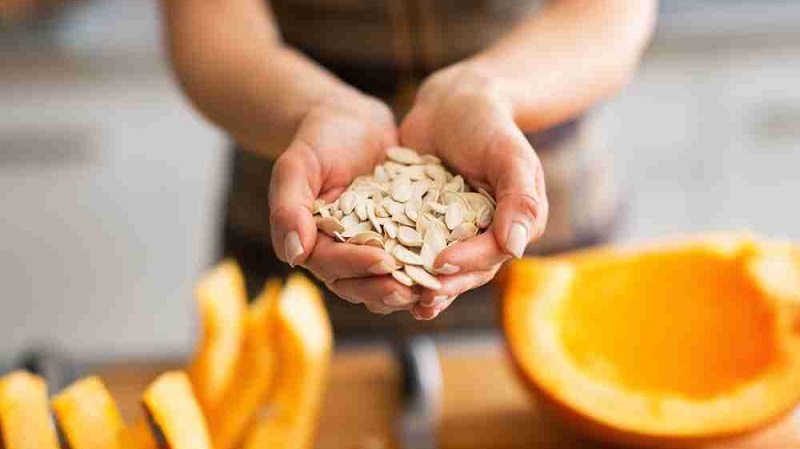
Usage rates
The daily norm of the cooked product is 200 g. This will saturate the body with vitamins and minerals, maintain the balance of nutrients, without fear of sudden surges in sugar.
Natural vegetable fresh you can take 3 tablespoons three times a day.

Pumpkin in folk medicine
Since ancient times, pumpkin has been used for the preparation of various medicines at home. Moreover, all parts of the melon culture are used: pulp, seeds and tops.
External use
In folk medicine, the vegetable is used to treat complications that occur with diabetes. Often, patients are worried about poorly healing wounds and trophic ulcers on the skin.
The most effective remedy is pumpkin flower powder. They are sprinkled with wounds, creams, ointments and masks are prepared on its basis. A decoction with healing properties is boiled from fresh inflorescences. For example, for a compress, gauze is soaked in liquid and applied to the skin.
Decoction recipe:
- water - 250 ml;
- crushed flowers - 3 tbsp. l.
Boil the mixture over low heat for five minutes and leave to infuse for 1 hour. Then strain through cheesecloth.
Contraindications
The melon culture will have to be completely abandoned when:
- gastritis with low acidity;
- violations of acid-base balance;
- complex course of diabetes;
- low blood pressure;
- individual intolerance;
- gestational diabetes in pregnant women.
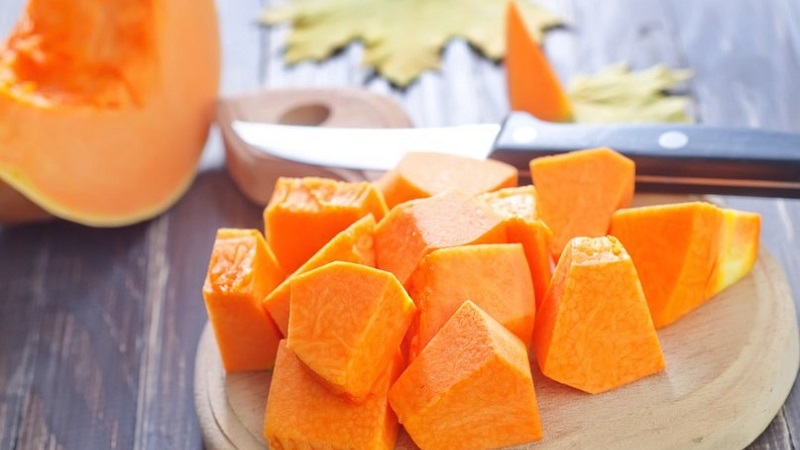
Benefits and harms for insulin-dependent patients
With type 1 diabetes, you should not completely give up pumpkin. With moderate consumption and accurate calculation of bread units, compliance with daily norms and constant control of sugar levels, you can afford to enjoy a piece of healthy pulp.
If, after eating pumpkin, the glucose level rises by more than 3 mmol / l compared to the measurement before eating, the product will have to be discarded.
It is worth mentioning that pumpkin helps with diabetes:
- keep weight under control;
- remove toxic substances;
- normalize the digestive tract;
- reduce the level of "bad" cholesterol.
Tips
Diabetes mellitus is not a death sentence. With this disease, you just need to learn to live and control what you eat. People united by a common problem communicate on forums, create communities, teach beginners not to despair, share tips and recipes for cooking.
As for eating pumpkin, take note of a few tips from people who are faced with an unpleasant diagnosis:
- Eat raw pumpkin for breakfast.
- For thick pumpkin porridge, use millet or couscous as a thickener.
- Combine pumpkin juice with apple, cucumber or tomato juice and drink before bed.
- Don't forget pumpkin seeds. They will help lower your blood glucose levels.
- Use safe sweeteners (stevia, fructose) instead of banned white sugar. Add honey only after consulting a doctor. In some cases, the product leads to surges in sugar.
- Combine the vegetable with dill and parsley. Greens have been shown to regulate sugar levels.
- Eat slowly, chewing thoroughly. Remember fractional meals.
- The baked pumpkin can be flavored with butter after removing the dish from the oven.
- The vegetable is safe in boiled, baked and raw form. Forget about frying in oil.

Conclusion
Eating pumpkin is not a panacea for diabetes, but just one of the ways to normalize the condition. There is no need to follow a strict carbohydrate-free diet, it is important to carefully choose the foods that will make up your daily menu.
The correct introduction of melons into the diet, compliance with daily norms and rules for heat treatment will saturate the body with useful substances and keep the sugar level under control.